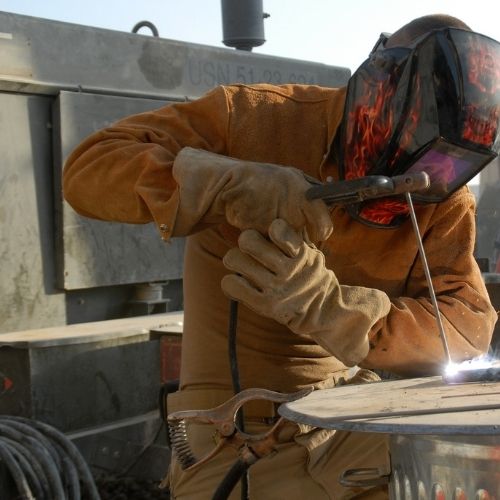
If you are just getting started in the world of welding, then you must have noticed that your welding clothes keep getting burn marks and potentially even holes. Even though welding clothes are much more robust than normal shirts and gear when it comes to withstanding heat, even they can’t sustain long term exposure to welding. There are some tips and tricks through which you can increase the longevity of those clothes while at the same time protect yourself from burns. One of these tips is starching your clothes. This might seem like someone is pulling off a practical joke on you, especially if you have never heard of this technique, but trust me, it’s real and super effective.
Starched clothes offer another level of protection for your skin and for your clothes as a welder. This is one of the main reasons why welders starch their shirts, jacket, and jeans.
WHY DO WELDERS STARCH THEIR CLOTHES?
Contents
If you have been welding for some time now or if you have just started out, you must have noticed that your welding clothes don’t really last that long. After some time, they will be full of holes and be covered with slag and dirt. When your clothes get to this point, it becomes tough to keep wearing them, chances of your skin getting burns will increase and, you don’t want to take that chance.
After a couple of times of buying a new pair of jeans and a shirt, it becomes tedious and expensive. There are some options available out there which will last longer but at the same time, they cost a lot more. Many of the people, even some professional welders don’t prefer buying expensive FR clothing. The other route they take is to starch their own clothes. This way they create their own flame-retardant welding clothes at a fraction of the cost.
HOW DOES THE STARCH HELP?
If you are able to starch your clothes properly, it prevents the slag and spatters from going through the garments. Most of the burns that people get through welding can be up to 3rd-degree burns, when clothes are starched properly, it can help protect your skin.
The properties of starch act as a flame retardant and also prevent dirt and debris from collecting on your clothes. Starching may not turn your clothes into some super full flame-retardant garment, but it improves the overall life of the clothes when compared to the original.
The starching method has been in use for a long time. Wearing starched clothes does take some time getting used to, there is a chance that you may not like the feeling of it in the beginning or may not get used to it at all.
WHAT TYPE OF EQUIPMENT SHOULD YOU STARCH?
Any protective gear that you are wearing and is made up of cotton or denim can be starched, including shirts, pants, apron, jackets, sleeves, and even gloves. You don’t need to starch your boots or your helmet as they are made up of special fire-retardant material and not natural fibers.
HOW MUCH IS IT TO STARCH YOUR PPE?
When it comes to starching your personal protective equipment, it does not involve a lot of additional costs, you can easily do it at home. The first thing you will need is any commercially available starch, some people even use corn starch which you can buy at any grocery store.
The next thing you will need is a spray bottle and an iron or a steamer. Actually, in all of the procedures, the most expensive thing you might need to buy would be the iron or the steamer. Make a note that a steamer is more expensive than iron. But if you already have this then your entire cost will not be more than 20-30$.
A lot of laundry services offer to starch your clothes for 5-8$ per clothing item. So, you can get your entire outfit starched at 20-30$. Keep in mind that the same cost for personal usage will last for multiple starching sessions, saving you some money in the long run.
SHOULD YOU STARCH YOUR OWN CLOTHES
This point comes down to your preference more than anything. You can take the clothes you want to get starched to a laundry or someplace which offers this service and it might not even cost you a lot. This way you can save time and effort but on the other hand, if you choose to do it yourself you might save some money if your financial situation doesn’t allow for side expenses. It might also give you the satisfaction of doing it yourself. This decision truly depends on your individual preference.
Another point to note is that if you have not starched your clothes before, then it might need a bit of practice or a trial run before you starch any expensive clothes.
HOW TO STARCH YOUR WELDING SHIRT AND PANTS?
The starching process is not that difficult, it might need some practice to begin with, but you will get the hang of it. The things you will need is a spray bottle, some form of commercial starch, and an iron or a steam press.
The first step you need to do is to make sure that your clothes are washed and dried. Starching dirty clothes will not give you the results you are hoping for. Once this step is complete, we can move ahead.
The second step is to put whichever starch you are using into a spray bottle and spray it on top of your clothes. Hanging the clothes on a hanger would be the right approach as it is efficient and easy. You should let your clothes dry overnight or for a day to let the starch completely soak in the clothes.
Once this step is complete, you can steam or iron the clothes. Steamers may cost a bit more than iron but both methods are equally efficient.
Make sure that the clothes you are starching are 100% cotton or denim or natural fibers. The results will not be the same on synthetic material.

FREQUENTLY ASKED QUESTION
This might be a new and weird technique that you are learning about and no doubt you will have a lot of questions and confusions. It is always better to clear any doubts before trying something new. I have tried to cover all the most common questions that people have related to this technique below.
Starching black clothes is a little tricky. It might leave some visible marks on the shirt or the pant that you will be going to use. You can turn the clothes inside out and starch the inside rather than the outside, it will protect you from the burns and slag while not destroying your black garments. It might be more uncomfortable on your skin though.
As I mentioned above, the best clothes to starch are the ones that are made up of 100% natural fibers. 100% cotton is the best one to use. If you use denim make sure it’s not mixed synthetic materials. Synthetic materials catch fire easily and also have a tendency to stick to the body.
You should only starch clothes that you are going to wear, don’t starch them if you are going to end up storing them. Starch can sometimes attract insects which can eat away your clothes. you should also note that starch can shorten the lifespan of your clothes in the long run. Starch has the ability to settle down and eat away your garment fibers over time. Starching welding clothes will increase the life of normal clothes during welding but not when it comes to wearing them over a period of time. Another thing which you should keep in mind is the uncomfortable feeling of wearing heavily starched clothes, you might need some time getting used to it in the beginning.
Heavy starching your clothes can save you the trouble of stain removal and washing it off is way easier as compared to when it’s on fabric. The method for heavy starching is pretty much the same as the one above.
CONCLUSION
In conclusion, starching can prolong the life of your welding clothes and can even save your skin from burns and heat if done properly. It is better than buying expensive fire-resistant clothing at 4-5 times the price. It is better to practice the starching method if you are doing it yourself on some inexpensive clothes first. The whole process is pretty easy, and you can even get it done by a professional, it might save you some time. Always remember that you should prefer 100% cotton materials for starching and welding, they will last the longest and will also provide the best protection.
Make sure to follow all the safety precautions before starting your welding!
